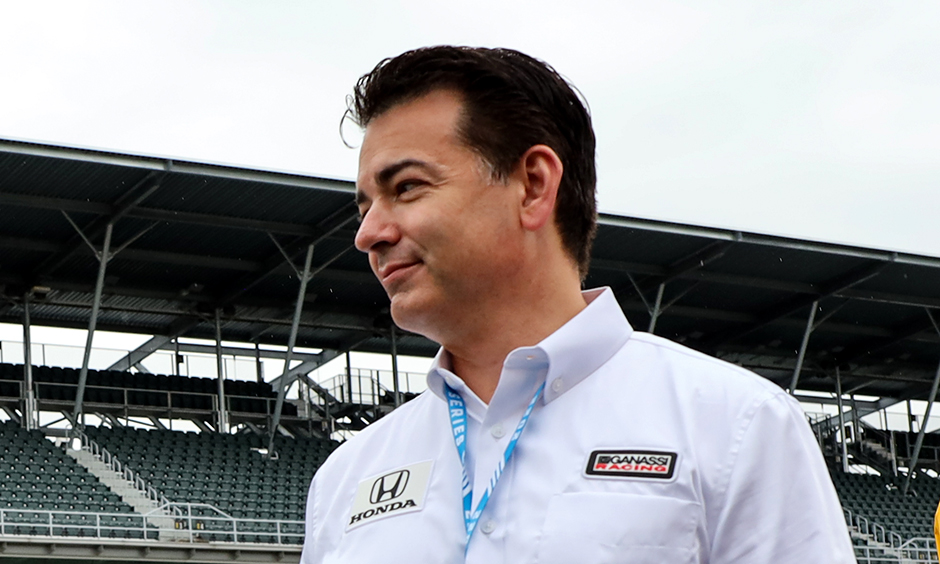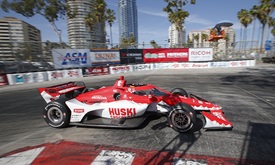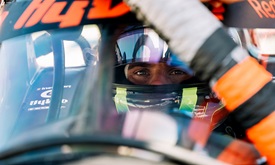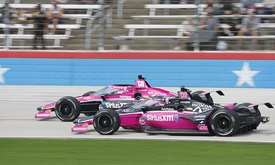The Setup: Long Beach with Chris Simmons
APR 11, 2023
Note: This is a new series for INDYCAR.com, with different guests, leading into each race weekend for the NTT INDYCAR SERIES, focusing on various technical challenges of each respective circuit.
The NTT INDYCAR SERIES is heading to the West Coast for the third round of the 2023 season with this weekend’s Acura Grand Prix of Long Beach.
The 1.968-mile temporary street circuit features 11 turns (six lefts, five rights), which includes a scenic run-down Shoreline Drive as part of the path that wraps around the Long Beach Convention Center.
There will be two practice sessions, an NTT P1 Award qualifying bout and morning warmup ahead of Sunday’s 85-lap (167.3 miles) race set for 3 p.m. ET (live, NBC, Peacock, INDYCAR LIVE and the INDYCAR Radio Network). The qualifying record is held by Colton Herta, who throttled to a fast lap of 1 minute, 5.3095 seconds (108.480 mph) to capture the pole last year.
This week’s featured guest is Chris Simmons (photo, above), performance director for Chip Ganassi Racing. In his previous race engineering role, Simmons helped guide Scott Dixon to victory at Long Beach in 2015, their first year working together.
Q: What is it like preparing for Long Beach?
Chris Simmons: It's our first big trip of the year, so it's not really different than any other street course race, but the history of Long Beach and the track layout has some unique features, for sure. Long Beach is more of a middle-of-the-road street circuit. It's not super-bumpy like the old Detroit was or like some of the other circuits we've been to in the past that have been super-bumpy. But it's not as smooth as St. Pete, either. It's kind of on your normal street course scale. The thing that's a little different about Long Beach is the length of the straightaway; for a street course is somewhat out of the ordinary. So, that affects more race aero(dynamic) settings than qualifying, because for qualifying you're pretty much still going to go with the max downforce or near max downforce. For the race, just people trying to make passes or keep from getting passed, a lot of times you'll trim out a little bit more than you would've just about any other street circuit we go to.
Q: Generally speaking, what type of setup do you lean toward and how is that different to other street circuits?
Simmons: Long Beach doesn't have any high-speed corners. There's some that we would consider medium-speed corners, but there's no true high-speed, aero-dominated corners. So, the aero is most important for braking. Obviously, it still affects the medium- and even slow-speed corners. It's an important part of your setup, but you want to have mechanical grip. But both mechanical grip and aero grip, you want to have the car low in the corners, which is a challenge with the speed of the straightaways and the bumps and then most of the corners being on the slower side. Keeping the car low for those corners is a challenge. So, you do some more creative things with third springs and third bump stops, and that affects your setup, for sure. And you look a little more toward the hairpin (Turn 11), and getting off the hairpin is one of the most important determinators of not only lap time but passing or not getting passed.
Q: What is the most difficult section of Long Beach?
Simmons: The hairpin being the slowest corner and going on the longest street dominates a lot of your lap time, your car performance and your setup. But there's some trickier places on the track that you have to be able to get through, as well, including the corner onto the backstretch (Turn 8), and the corner before that (Turn 6) has kind of a curved exit. Turn 6 and Turn 8 are both quite tricky. And then the fountain section (Turns 2-3) has its own challenges, as well. Between there and Turn 5, you actually have some curbs that you hit, which isn't all that common on a street circuit, so that affects damping, as well. But everything's really dominated by, “Can we get off the hairpin or not?”
Q: Does anything transfer over from the street circuit event in the season opener at St. Petersburg?
Simmons: There's some that transfers, but the unique aspects of St. Pete, where you have a bit of a bump in Turn 3 and then in the Turns 10-11 section, kind of limits what you can do with third springs, whereas Long Beach, you don't really have those challenges much. So, that affects your starting ride heights and from there affects everything downstream mechanically on the car.
Q: Qualifying seems especially important at a place like Long Beach, with it being tight and track position being key. That said, how do you find that balance to make sure you’re not too far in one direction or the other from qualifying and the race?
Simmons: Yeah, like you say, qualifying is uber-important. Even with a long straight like we have at Long Beach, passing is not easy. And you're really not going to do it without using push-to-pass. You have a limited amount of that, so the further up you start the better. And there are some fairly significant differences between qualifying setup and race setup. Qualifying setup, we're trying to get ultimate performance out of the tires and in two or three laps at most, whereas the race we're going 20-30 laps, depending on strategy. So, you give up a little mechanical grip in qualifying to have more peak performance out of the tire and to have more platform in the car, a little bit more rigid setup, more direct for the driver. In the race, you're going for more all-out mechanical grip, softer setup. Our (car) rolls and pitches around a bit more, a little bit harder for the driver to place, but the grip stays more consistent over the long run.
Q: When it comes to the elements and what a driver like Scott Dixon, regarded as the best in the business, prefers, is that tricky to find exactly what he likes at a circuit like Long Beach?
Simmons: Well, Dixon is the best in the business because he's so adaptable. He can drive around a lot of deficiencies in a setup and can adapt to changing conditions. But Long Beach is definitely a place where you have a morning warmup on Sunday, and you don't want to get too out of control tuning the car for those conditions because it's not what you're going to have for the race. The wind is almost certainly going to flip direction. Track temperature is going to come up significantly, especially if there's a marine layer. So, you just have to be careful not to get the car too free. Scott's definitely a driver that likes a strong front end, where Dario (Franchitti) was definitely much more of a driver that wanted the rear to be planted and could deal with a little more understeer. They could certainly drive each other's setups, but Scott's a guy that wants a very positive front end. You can get yourself in trouble in the cooler conditions in Long Beach if you tune too much toward that and then it warms up, and typically the rear goes away more than the front as it warms up. So, especially with the traction you need out of the hairpin, you got to be careful not to get too far out of whack when the temperatures are different than what you're going to race in.
Q: Does the track tend to get grippier over the course of the weekend or is it the type of place that loses grip as things go on?
Simmons: I think grip level is going to be one of the big question marks going into this weekend. Last year, we all had a bit of a surprise where they sealed most parts of the track, and the grip was a lot higher than we've had in years past. And because of that, and that was right from the beginning, the track evolution was less than what we've seen in the past. So, depending how much of that sealer remains and how degraded it's become over a year, and if they've made any other changes that we haven't seen yet, is going to affect that track evolution and the starting grip level and where we might get to. The other unique thing about grip level at Long Beach is the drifting cars have some pretty soft rubber that they put down a lot of in the last complex of corners – Turns 9, 10, 11 – there, where they do their most of their drifting stuff. So, that area of the track typically has a much different grip level than the other parts of the track where IMSA, INDYCAR and all the other support series run. So, it creates some challenges, setup-wise, driving style-wise and certainly simulation-wise.
Q: Earlier, you mentioned a “marine layer” affecting setups. What exactly is that and how does that impact things?
Simmons: On the West Coast, it's common to get a marine layer, a layer of clouds over the cooler ocean. And then during the night that covers land, it actually keeps the air temp up a little higher because it reflects some of that radiated heat from the ground back down, but it also slows the warming of the track in the morning. So, the track temp will be lower than what it would be even later in the afternoon; even if it remains cloudy, that marine layer won't be as thick, typically, and then that also affects how the sea breeze develops. Long Beach, particularly being right on the coast, is very affected by that. I can't tell you how many times I've looked at the weather forecast and done the simulation and thought this is the top gear we need for the race, and you walk out of the truck to go to the grid and the wind's still going the wrong way and you're like, "Man, when is it going to flip?" And then five laps into the race, it usually does, and hopefully you have the right gear by then. If not, you can be wildly off on top gear, which is not good for passing or performance.
Q: Lastly, it’ll be the second time this year the Firestone guayule (green sidewall alternate) tire will be run this year in the NTT INDYCAR SERIES, with both being on a street circuit. What do you anticipate with that?
Simmons: Firestone typically brings the same tires to all the street courses, but the track surface itself is different so the tires act differently. So, it's always a bit of a mystery. With the sealer that went down at Long Beach last year, that drastically affected the grip level and the performance of the tires. Times were super-fast right from the get-go last year. I think Practice One was quicker than qualifying on reds (alternate tires) was the year before, or right there anyway. That throws a bit of a wrench in everybody's preparation because the trade-off between mechanical grip and platform stability shifts, and you got to keep up with that to keep the driver happy and to maximize performance. That tire was a little bit different at St. Pete than what we had last year. It's a good tire; it's just a little different. So, it's one more thing for us to adapt to. It has changed a bit from a few years ago, though, where we wouldn't see that tire until qualifying. Now, we at least get to do a little bit of practice on it and get a bit of a taste of what we have coming and what the grip difference is between the standard tire and the guayule tire.



















